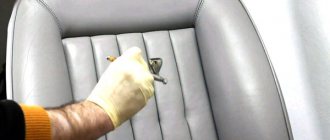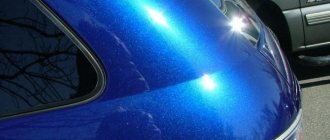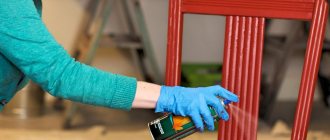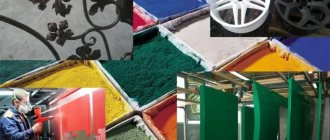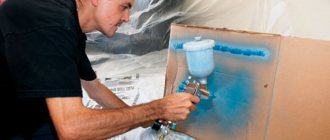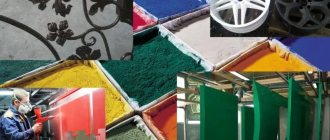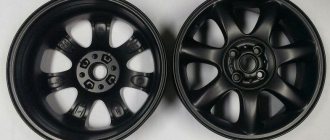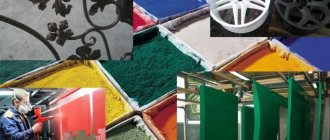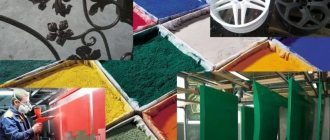To restore your car yourself, you need to take care of the interior. It is this part that suffers the most from use and needs high-quality painting. Here the driver spends a lot of time; his communication with the car consists of using interior parts. Therefore, they should always be kept in perfect order. To prevent car plastic paint from peeling off and fading prematurely, you need to follow the recommendations and purchase high-quality materials. Your car will again become more attractive and will be able to please you with wonderful emotions during operation.
The most difficult parts to paint are plastic parts. Here, the structural surface creates certain difficulties during restoration and does not allow the layer of old paint to be properly cleaned and new materials to be applied. In order for the plastic in the cabin to be as good as new, it must be looked after, treated with polishes and protective agents. If the appearance has already deteriorated, you will have to take on repair work. When working with a car interior, the most important stages are the correct choice of products for painting, as well as proper processing of the part before applying materials.
Choosing high-quality paint for car interior parts
Selecting suitable materials is one of the most difficult stages of completing a job. If you have never dealt with car paint issues, restoring plastic will be a rather complicated process for you. A car needs a professional approach at every stage, including when choosing products. You won't need a primer for salon elements, but specialized materials for painting will come in handy. You need to pay attention to the following points:
- special purpose for plastic - products can be used for car bumpers;
- the ability to paint structural surfaces, which is inherent in all auto paints for such tasks;
- manufacturer - choose well-known companies such as Motip or KUDO, you can use Polish Farbid;
- price - if the cost is too low, there is a possibility of purchasing a fake instead of the original;
- packaging form - the easiest way to work with aerosol options, since they do not require a compressor.
It is also worth acquiring rags, solvent and thinking about devices for hanging or laying plastic parts when applying paint and varnish products. Take care of everything in advance so that you don’t have to run around looking for scrap materials around the car when work begins. It is best to paint the interior elements of your car with products with a quality guarantee. In the store, when purchasing, you can ask for documents for the goods.
Types and characteristics
Ease of use is the main reason why spray paints for plastic have become so popular. The following types of aerosols can be produced in the form of cans:
- Monadic. They are used for PVC. They are resistant to ultraviolet rays and adhere well to the base.
- Soft Touch. A type of coloring composition that is pleasant to the touch makes the surface rubberized and velvety. This enamel looks great in any conditions.
- Structural. They create a decorative coating that also feels rough to the touch. Thanks to this, the slightest defects are hidden. An excellent option for surfaces that are subject to constant mechanical stress.
- With additional protection against damage. Compositions with particularly high strength; acrylates are added to their base along with polyurethane additives.
- Polymer. Combines the functions of a primer with a dye. Known for their high level of adhesion. No preliminary priming is required before starting work.
Interior preparation and processing of old paint
The plastic in the car interior needs very high-quality processing. The specificity of painting materials is such that incorrect application will result in drips, color transitions and unpainted parts. All this causes certain difficulties. Interior plastic paint can adhere normally only if the part is first prepared. To do this, a fairly simple procedure is performed with the following procedure:
- The parts are removed from the car. This must be done carefully, as some plastic elements are very easy to damage. If we are talking about the panel and door cards, you can leave them in place, closing everything around.
- If the enamel is applied to a greasy and dirty surface, all the paint material will simply run off. So, to begin with, the plastic is degreased and cleaned of all kinds of contaminants.
- The next step is to sand off the old paint using water and fine-grit sandpaper. Use P 1500-2000 on a waterproof base and constantly feed water under the abrasive.
- Next, the interior is protected from paint getting on all kinds of elements, otherwise you will have to scrub them off later. To do this, use thin masking tape and film or newspapers to create protective screens.
- The last thing you should do is degrease the surface again and apply paint with gentle movements. This will help to quite easily maintain the evenness and quality of the plastic surface and restore freshness to the interior.
In order for the car to become beautiful again, you must apply the purchased materials efficiently and without errors during the work process. Otherwise, the paint will run off, will not dry, or will be very different in color. Remember also that when painting local plastic parts you will have to use the transition painting method. This is not possible using a spray can; professional equipment will be required. Interior plastic paint is sold not only in aerosol form, but this is the most convenient way to use it.
How to paint car interior plastic
Let us immediately note that the concept of “painting” is complex. Without any lyricism, painting a plastic interior element means:
- Sand it.
- Degrease.
- Find out whether it needs to be primed or not.
- Restore texture if necessary.
- Paint it the desired color.
How to sand
To matt interior plastic under primer, red Scotch-Brite is usually sufficient. It is a felt-based abrasive material, similar to the hard side of a dish sponge. The advantage over fine-grained sandpaper is its softness, which allows this tool to efficiently process various bends and indentations.
How to degrease
Experienced painters advise using only anti-silicone. The fact is that classic solvents in the form of white spirit or solvent can ruin a plastic unit. For example, after using organic matter, stains form that are difficult to hide even with painting. By the way, we have already recommended abandoning white spirit when performing the technology that describes how to remove tar from a car body without damaging the paint.
Do you need primer on plastic or not?
The reason for fresh paint clumping and peeling is that no primer was applied first. This is a composition with a special formula of various additives and plasticizers, which improves the adhesion of paint to the surface. However, not all plastics require primer treatment. To determine whether to prime the interior plastic or not, you need to conduct two experiments:
- Set fire to a piece of the product being processed.
- Immerse the part in water.
If the plastic smokes and sinks, it is not necessary to use primer on the plastic.
When a plastic element burns like a wax candle and floats on water, you cannot do without a primer. It is important to choose the soil wisely. So ordinary automotive compounds are not suitable - the paint peels off instantly. You need a special primer designed specifically for plastic.
When is structural paint needed?
If you have ever touched a black plastic bumper or a dark side mirror housing on an inexpensive car, you probably felt that the tactile surface seemed to be covered with small pimples. The matte rough effect is structural plastic. The paint in question recreates this same effect and is typically used to cover up scuffs and light scratches.
How can it be useful when preparing interior parts for painting? At a minimum, this component allows you to restore worn and slightly damaged areas of the restored element. As a maximum, a layer of structural paint protects surfaces from damage. And this is fully relevant for parts with which the crew actively contacts (door handles, handles, etc.).
What about the paint itself?
First decide what kind of coverage you want to get. Here are some examples:
- Soft-Touch. Usually used for dashboards. The surface is slightly silky and rubberized. This coating is applied to the panel from the factory.
- Normal, rough. Apply to hard plastic. For example, the side parts of the center console, lower trims on door cards or handles for closing doors.
- Glossy. Used for finishing interior levers intended for opening the door.
Then find out for yourself which shade to choose. If you plan to paint the interior exclusively in a restoration manner, then take the trouble to find a company catalog with the distribution of interior and exterior colors by VIN numbers. The original paint, selected according to the factory catalog (for example, for VW it is ETKA), will preserve the monotony of the overall picture of the interior. This will be because there will be no noticeable difference between the painted and unpainted parts.
For your information. For restoration work, it is better to order original paint and only from the car manufacturer.
If we talk in terms of the examples given, then it is better to purchase the Soft-Touch aerosol can through the official line. To get a regular rough layer, it is enough to use classic paint paired with structural paint. Here are examples for common shades:
- Black. The VAZ black Cosmos (code 665) will do.
- Grey. The VAZ decorative (graphite) intended for bumpers fits perfectly.
However, the color and origin of the paint are purely individual things and are selected solely according to one’s own preferences. Continuing the conversation about rough coatings, it is appropriate to mention the well-known RAPTOR U-POL, a protective coating for the exterior of a car, and its similarity - HB BODY.
Glossy objects are regular paint covered with several layers of varnish. The latter is recommended to be purchased in aerosol cans. There are no strict requirements for this component.
We recommend painting plastic parts of the car interior only with a spray can. When applying enamel with a brush, there is a risk of drips. In addition, such a layer takes much longer to dry, which means that the likelihood of catching dust particles is much higher.
How much paint do you need to buy for interior parts?
Structural surfaces are unpredictable when applying paint and varnish products. In one car, a 400 ml bottle is enough to paint the entire interior, while in another, the same amount of material will be used for one large part. It is quite difficult to predict consumption. Each car is individual, but there are certain general criteria. When purchasing materials, consider the following features:
- You should not buy less than 400 ml, although you can find more compact packaging on store shelves;
- an aerosol can with a small volume will quickly lose normal pressure and will not help paint the interior efficiently;
- if you plan to paint plastic throughout the entire interior, you should immediately buy at least two cylinders with a reserve;
- before painting plastic, you will have to practice painting unnecessary car parts for experience;
- For normal results and successful car repairs, it is better to have more aerosol than you need.
Considering the affordable cost of cylinders, you can take products for cars with a small reserve. You can always find something else to paint in the car in order to get normal use of the vehicle’s interior. But to paint one small car part, you won’t need to buy too many paint products. Otherwise, the cost of your car restoration venture will be too high.
The nuances of choosing paint in spray cans
The first thing you need to know is what type of plastic your parts are made of, since the further choice of the properties of the dye and the technology for its application depends on the material itself.
- ABS (Acrylonitrile butadiene styrene) - housings for household and computer equipment, mobile phones and much more are made from it.
- PVC (Polyvinyl chloride) - window structures, floor coverings, children's toys and goods, some types of household containers.
Let's sum it up
Every car owner wants to make their vehicle more attractive. There are many ways you can implement this noble undertaking. But often methods involving professionals turn out to be too expensive. Therefore, potential customers of paint booths and service stations prefer to buy the necessary paint themselves and do the work themselves. This is much cheaper, but does not always give the desired results. It is important to choose the right methods and tools.
When working with plastic, you should protect the interior as much as possible from enamel and prepare the part for applying auto paint. Also, do not forget that there are quite a few brands on the market offering painting products in a variety of price segments. It is much easier to immediately buy good material and not overpay later for the restoration of poorly painted parts. It will be cheaper and more profitable in all aspects, and the owner of the vehicle will be able to show himself in taking care of his car.
What to look for when choosing?
Before choosing one or another composition, you need to know the requirements that such paints must meet:
- Compliance with the substrate being processed. The manufacturer writes in the instructions what type of plastic can be treated with one or another product.
- Aesthetics. The choice of materials largely depends on what kind of result the buyer wants to get, and on how moisture resistant the mixture should be.
- Water resistance level. Ideally, all acrylic paints created specifically for plastic have this property. After drying, they form an additional protective film, which can be processed without any problems. But in conditions of high humidity you cannot do without additional additives. The most commonly used are polyurethane varieties. They are always waterproof.
- Indicators of spreadability, hiding power. They show how thick and even the layer of material is on the surface.
- Base compatible. The paint for plastic must match either the material itself or the primer that has already been applied to the surface. Otherwise, the coating will quickly begin to crack.
- Adhesion. For most compounds, adhesion to working surfaces is at a decent level. You just need to take into account the composition and smoothness of the plastic object itself that requires processing.
In the video: enamel primer for KUDO plastic.
Characteristics of paint for plastic
Harmlessness and environmental friendliness are the first criteria for choosing a quality product. Manufacturers often produce paint with components that are harmful to health. The critical impact on the human body occurs at the time of painting, and throughout the subsequent operational period.
Harmful secretions are provoked by climate, temperature and humidity levels.
- Coloring agents vary in their resistance to possible damage. The impressive level of wear resistance guarantees the durability of the coating.
- Specific care is provided for a painted wall, based on the composition of the paint. Some products do not tolerate wet cleaning, so you have to clean the walls of dust and dirt with dry cleaning agents.
- Eternal paints are sold that are not afraid of wet processing. But stains on the wall either cannot be removed at all, or you need to try really hard.
Washable paint does not attract dirt and can be treated with alkaline solutions. They sell products with low performance indicators that cannot withstand steam, cigarette smoke and fats. This coloring product is more suitable for dry rooms.
An important property of high-quality paint is hiding power, which allows it to cover the existing color of the old wall. It is enough to apply 2-3 layers so that the old color does not interfere with the creation of a new design.
Daylight and sun rays have a negative effect on the paint layer. However, the specialized composition will withstand exposure to ultraviolet radiation. Otherwise, the saturation of the shade is lost in a short period of time. A burnt-out wall looks unattractive.
High paint costs are caused by low-quality products. Expensive materials are economical, which allows you to get by with one layer. Next, we will consider the variety of coloring mixtures and choose the best option.
Advantages of varnish for plastic
Experts highlight a number of positive qualities of aerosols for processing polyurethane parts.
They are as follows:
- Moisture protection;
- Prevents mold growth;
- Creates a protective shell;
- Increases anti-corrosion properties;
- Have high adhesion;
- They have dielectric properties.
The aerosol must be applied to a clean and dry plastic surface. Work with paint and varnish compositions must be carried out in conditions with moderate humidity.
After each layer, it is recommended to observe complete polymerization. After this, the surface is carefully polished to obtain a glossy shine.
Some recommendations for varnishing
To enhance the depth of color and a more impressive appearance of a plastic product, it is recommended to apply varnish to the surface in at least two layers. This is especially true for products made of metallized and translucent plastic. In general, the more layers, the better.
Each subsequent treatment should be carried out some time after the previous one. You can learn about interlayer drying intervals from the instructions for use of a specific varnish solution. Polyurethane water-based varnishes “touch-free” dry within 2-3 hours, completely dry in a day to a day and a half. But even after this, it is not recommended to test the coating for strength for at least another week, that is, to wet it.
Small plastic items can be dipped into the solution or painted with a brush. But during drying, hanging droplets may form on the bottom of the product, which must be carefully removed while the substance is still liquid.
Another thing is to use an aerosol. But here too it is important to ensure that the varnish evenly covers the entire surface. Therefore, re-application is recommended to eliminate any possibility of omissions.
Polymer materials themselves are quite durable. But using special protective varnish coatings, you can not only extend the period of use of the product, but also prevent negative influence from the outside. And, of course, to maintain the proper appearance of materials longer.
Pros and cons of spray enamel
Aerosol paints are easy to use. You don't need special skills, training or additional expensive equipment. It is enough to follow simple recommendations from the manufacturer.
The advantages of enamel also include:
- Smooth smooth surface. Modern spray can heads are made in such a way as to imitate the torch of a paint spray gun. This allows for uniform spraying of the enamel, resulting in an even, smooth surface layer.
- Drying speed. Aerosol paint dries very quickly, which is an undoubted convenience, since you do not have to spend a lot of time on work and speed up drying using additional methods.
- Economical consumption. Balloon enamel is consumed slowly and one can is enough for a large surface.
- Convenient storage. There is no need to create special conditions for storing unused residues, pouring and carefully closing, as is the case with canned paint. The enamel in the container is stored for a very long time and reliably.
- Large palette of colors and structures. This allows you to achieve great artistic expressiveness and imitate many surfaces, for example, metal.
However, the surface area to be covered using a spray can is small. It is impossible to mix paints to obtain the desired shade. As a rule, there is a certain set of colors on sale, so it is not always possible to accurately match the tone of the wallpaper or window details.
Complex shades and the required quantities can be ordered from color matching laboratories, but this will cost significantly more.
Cons of spray paint:
- If you bring the aerosol too close to the surface to be painted, smudges may form on smooth plastic. To work with spray cans, you need to acquire skills and dexterity.
- Large spray area. Elements to be painted will either have to be dismantled or the adjacent surfaces will have to be protected from splashes using film and special paper tape.


